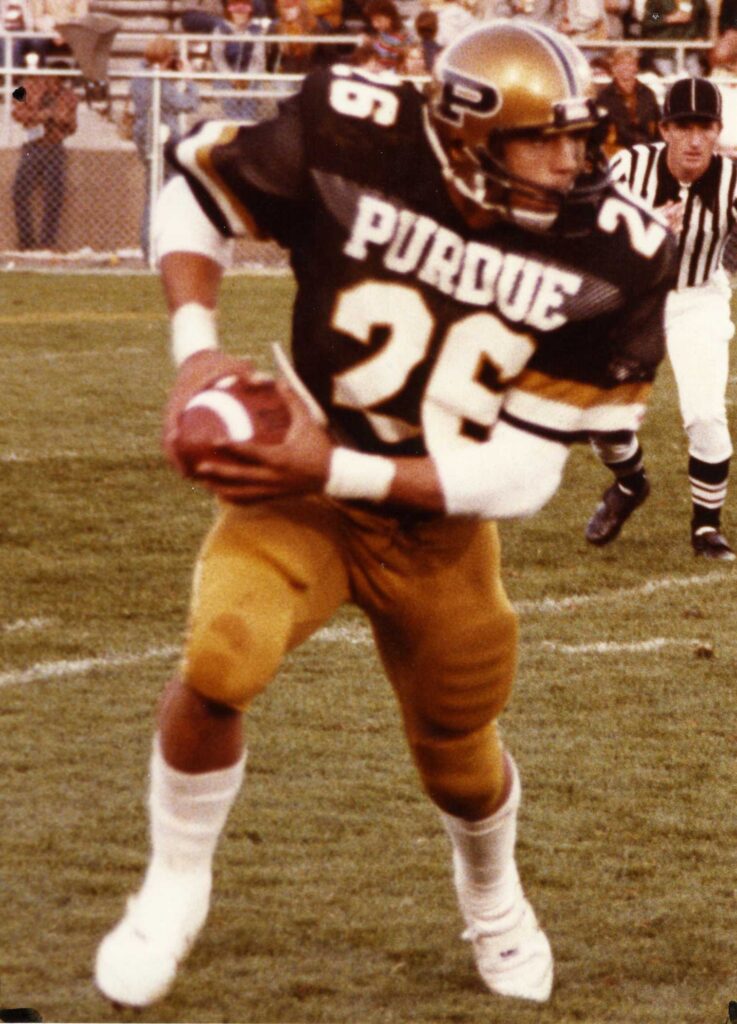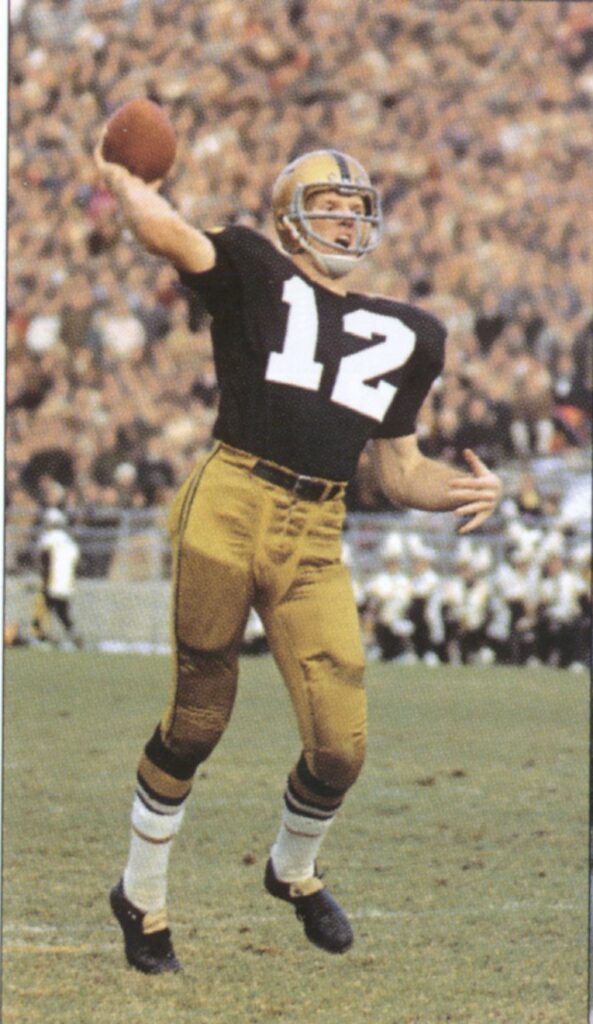One Man’s Ranking of Purdue Football’s Previous First Round Draft Picks



George Karlaftis became the 24th Purdue football player taken during the first round of a professional football draft, going 30th overall to the Kansas City Chiefs last week.
His selection ended an 11-year first-round drought for the Boilermakers, whose last first-round pick was another All-American defensive end: Ryan Kerrigan.
Those 23 first-round selections include three Pro Football Hall of Fame members, seven Super Bowl/NFL champions and four members of the Cradle of Quarterbacks. Here’s one man’s ranking of the previous 23 first-round picks.
1. Rod Woodson – It takes a special talent to be named to the NFL’s 75th anniversary team as an active player and remain there as a part of the 100th anniversary celebration in 2020.
There were four other active players selected to the NFL’s 75th anniversary team in 1994. You may have heard of them: Jerry Rice, Joe Montana, Reggie White and Ronnie Lott.
Woodson went 10th to the Pittsburgh Steelers in the 1987 NFL Draft, the only player among the top 10 picks who someday would be elected to the Pro Football Hall of Fame.
Playing cornerback and safety in the NFL, Woodson was the NFL Defensive Player of the Year in 1992. His 11 Pro Bowl selections are a record for a defensive back.
Woodson earned a Super Bowl ring with the Baltimore Ravens, one of four teams he played for during a 17-season career. He entered the Pro Football Hall of Fame in 2009 with 71 interceptions, including an NFL record 12 for touchdowns. His 1,483 interception return yards were also an NFL record, since surpassed by Ed Reed.
2. Bob Griese – The late Bob Collins of the Indianapolis Star once opined that Griese lost the 1966 Heisman Trophy because consensus opinion was that the winner, Steve Spurrier of Florida, was the better pro prospect.
The San Francisco 49ers thought so anyway, trading three players to Atlanta to secure the No. 3 pick and Spurrier in the 1967 NFL Draft. Spurrier never beat out John Brodie in San Francisco, starting only 38 games in a 10-year career that ended with the winless Tampa Bay Buccaneers in 1976.
Griese went one pick later to Miami, whose fans were dreaming of Spurrier leading their second-year franchise to glory. Instead it was Griese who guided the Dolphins to two Super Bowl victories and three consecutive AFC championships.
In Don Shula’s run-first offense, Griese still threw for 25,092 yards and 192 touchdowns in 14 seasons.
Griese was elected to the Pro Football Hall of Fame in 1990 and the College Football Hall of Fame in 1984.
3. Len Dawson – The fifth overall selection in the 1957 draft by the Pittsburgh Steelers, Dawson didn’t blossom as a pro quarterback until reuniting with his Purdue quarterback coach Hank Stram with the AFL’s Dallas Texans in 1962.
Dawson led the Texans to their first AFL championship that year and was named the AFL Player of the Year. The Texans moved to Kansas City in 1963 and won another AFL championship in 1966 and the final AFL title in 1969.
Dawson was the Most Valuable Player of Super Bowl IV, leading Stram and the Chiefs to a 23-7 upset of the Minnesota Vikings.
Lauded by Stram as “the most accurate passer in pro football,” Dawson threw for 28,711 yards and 239 touchdowns in his 18-year career. He was elected to the Pro Football Hall of Fame in 1987.
4. Dave Butz – The first of a record three Purdue players going in the first round of the 1973 draft, Butz went fifth overall to the St. Louis Cardinals.
Typical of decades of poor management, the Cardinals lost Butz to free agency after two seasons when a mistake was discovered in his rookie contract. It cost Washington and coach George Allen two first-round picks and a second to sign Butz. For the next 14 years, the 6-foot-8, 300-pound Butz played in three Super Bowls and recorded 59.5 career sacks. He retired as the oldest starting player in the NFL in 1988 at 38.
Butz was selected to the NFL’s 1980s All-Decade Team and was chosen one of the 70 greatest players in Washington history.
5. Cecil Isbell – A legendary passer overlooked not just in Purdue football history but the NFL as well, Isbell was born too soon. Instead of a 10-15 year career like today’s star quarterbacks, Isbell’s pro career only lasted from 1938-1942.
The seventh overall selection by Green Bay in 1938, Isbell was so talented as a passer that he was named to the NFL’s All-Decade Team of the 1930s with just two seasons under Isbell’s belt. Isbell was even better in the 1940s, earning All Pro honors in 1941 and 1942 after leading the NFL in passing each season. The Associated Press’ first All-Pro Team in 1940 included Isbell.
As a rookie, Isbell was fourth in the NFL in rushing and fifth in passing. In 1939, Isbell helped the Packers win the league championship. By 1942 Isbell had become the first player in NFL history to surpass 2,000 passing yards and set a record with 24 touchdown passes.
Isbell retired following the 1942 season at age 27 to take the backfield coach’s job at Purdue. He left with a streak of 23 games with a touchdown pass. That mark stood until Johnny Unitas broke it in 1958. Brett Favre broke his Packers record in 2003.
Isbell died in 1985 at age 69.
6. Otis Armstrong – Taken ninth overall by Denver in 1973, Armstrong led the NFL in rushing with 1,407 yards in 1974. He rushed for 1,008 yards in 1976 and the next season helped the Broncos reach Super Bowl XII.
Armstrong rushed for 4,453 yards and 25 touchdowns before his career was cut short by a neck injury in 1980. He was elected to the College Football Hall of Fame in 2012 and died at the age of 70 in 2021.
7. Jim Everett – Purdue has had three players taken third in the NFL Draft and the most successful was Everett, who earned Pro Bowl honors with the Los Angeles Rams.
The Rams acquired Everett from the Houston Oilers, who already had future Hall of Famer Warren Moon at quarterback. Two first-round picks and a Pro Bowl guard was among the cost for the Rams.
Everett guided the Rams to three playoff berths, going all the way to the 1989 NFC title game. In 12 seasons that also included stops in New Orleans and San Diego, Everett passed for 34,837 yards and 203 touchdowns. He led the NFL with 31 TD passes in 1988 and 29 in 1989.
“I’m most proud that I had the guts, determination, to live out a dream,” Everett told therams.com in 2021.
8. Johnny Drake – Purdue’s first NFL No. 1 draft pick was the first ever choice of the expansion Cleveland Rams with the 10th overall selection in 1937. The Rams went 1-10 in 1937 but in his second season Drake earned the first of three consecutive NFL All-Star berths and was a first-team All-Pro in 1940.
Drake led the NFL with nine touchdowns each in the 1939 and 1940 seasons. He retired in 1941 with 1,700 yards on 525 carries with 24 touchdowns. Drake died in 1973 one day shy of his 57th birthday.
9. Abe Gibron – Long before he became coach of the Chicago Bears in the 1970s, Gibron was such a highly regarded lineman that he was taken in a secret draft.
Today it’s impossible to think any professional draft could maintain secrecy but the league executing that plan – the All-America Football Conference – was fighting for survival against the juggernaut the NFL had become by 1949.
The Buffalo Bills, not today’s Bills which were founded in 1960, took Gibron in the first round with the sixth overall pick. He earned AAFC Rookie Lineman of the Year honors.
Alas the secret draft would be the last for the AAFC, which disbanded following the 1949 season. Before the dissolution, Gibron ended up joining the kings of the AAFC, the Cleveland Browns. Paul Brown’s team, along with the San Francisco 49ers and the first Baltimore Colts merged with the NFL in 1950.
With Gibron in the starting lineup, the Browns won NFL titles in 1950, 1954 and 1955. He earned two All-Pro selections and four Pro Bowl berths. Gibron died in 1997 at 72.
10. Mike Pruitt – Another Cleveland Browns legend, Pruitt quickly showed why he went seventh in the 1976 NFL Draft.
Four times in five seasons starting in 1978, Pruitt rushed for more than 1,000 yards. Injury prevented him from making it five seasons in a row.
Pruitt earned Pro Bowl honors in 1979 and 1980. When Pruitt departed for Buffalo in 1985, his 6,450 yards only trailed Hall of Famers Jim Brown and Leroy Kelly in Browns history.
11. Ryan Kerrigan – Washington got an $8.72 million bargain when it selected Kerrigan 16th in the 2011 draft.
For the next eight seasons, Kerrigan started every game at outside linebacker. He intercepted a pass and returned it for a touchdown in his debut, the first of three times he would return an interception for a score during his career.
Kerrigan left Washington after the 2020 season for Philadelphia, taking with him the franchise record for sacks (95.5).
12. Darryl Stingley – Picked 19th overall by the New England Patriots in 1973, he had 110 receptions for 1,883 yards and 14 touchdowns over five seasons.
Stingley’s career was ended by a paralyzing hit from Oakland Raiders safety Jack Tatum during a preseason game in 1978. Stingley died in 2007 at the age of 55 of heart disease and pneumonia, both complications of his quadriplegia.
His grandson, LSU standout cornerback Derek Stingley Jr., was drafted third overall last week by the Houston Texans.
13. Anthony Spencer – The Fort Wayne native became an instant starter at outside linebacker after being taken 26th in the 2007 NFL Draft by the Dallas Cowboys.
His best season came in 2009, with a career-best 67 tackles and six sacks. Spencer had an almost identical season in 2011 with 66 tackles and six sacks.
Spencer reached the Pro Bowl in 2012 before injuries eventually led to his retirement in 2015. He finished with 33 sacks and 384 tackles.
14. Tom Bettis – Green Bay before Vince Lombardi was the Jacksonville Jaguars of their time when the Packers drafted Bettis fifth overall in 1955.
Bettis became a starting linebacker and held on to the job until future Hall of Famer Ray Nitschke took over late in the 1960 season. Bettis earned an NFL championship with the Packers in 1961 before being traded to Pittsburgh. Bettis added a second NFL title with the Chicago Bears in 1963 and a third as an assistant coach to Purdue graduate Hank Stram with the Kansas City Chiefs in Super Bowl IV.
Bettis died at the age of 81 in 2015.
15. Don Brumm – Taken 13th overall by the St. Louis Cardinals in 1963, Brumm played 10 seasons in the NFL as a defensive end.
He was selected to the 1968 Pro Bowl after recording nine of his 41 career sacks.
16. Leroy Keyes – The greatest player in Purdue football history never really got a chance to shine in the NFL thanks to injury.
As the third overall pick in the 1969 draft by Philadelphia, Keyes played running back, cornerback and safety. In 1971, Keyes (6) and fellow Eagles safety Bill Bradley (11) combined for 17 interceptions.
Keyes spent the final season of his five-year NFL career in Kansas City. A College Football Hall of Fame selection in 1990, Keyes died at the age of 74 in 2021.
17. Mike Phipps – The Cleveland Browns traded future Hall of Fame wide receiver Paul Warfield to Miami for the rights to Phipps, who was drafted third overall in the 1970 draft.
That move immediately got Phipps off on the wrong side of an opinionated Browns fan base and things never improved. Phipps became the Browns’ starting quarterback in 1972 and guided Cleveland to a playoff berth. A separated shoulder in 1976 led to his trade to the Chicago Bears in 1977 for a first-round pick, who turned out to be another future Pro Football Hall of Famer: Ozzie Newsome.
Like so many Bears quarterbacks after Sid Luckman, Phipps never excelled in Chicago and the arrival of Jim McMahon in 1982 spelled the end of his career.
Phipps was elected to the College Football Hall of Fame in 2006.
18. Dustin Keller – The New York Jets made the Lafayette Jeff graduate the 30th overall pick of the 2008 draft. Luckily for Keller, his first quarterback in the NFL was Brett Favre and the two hooked up for 48 receptions, 535 yards and three touchdowns.
Keller led the Jets in receptions in 2010 (55) and 2011 (65). Signing with the Miami Dolphins in 2013, Keller’s career ended with a serious knee injury suffered in a preseason game against the Houston Texans.
19. John Charles – The Rose Bowl MVP went 21st overall to the Boston Patriots in the 1967 NFL Draft. The defensive back played eight seasons in the league including a stop in Minnesota, where he was sent as compensation for the Patriots signing quarterback Joe Kapp in 1970. Charles spent his final four seasons in Houston, where he died in 2019 at the age of 76.
Leroy Keyes remembered Charles as a hard hitting defensive back who “if he had a chance to bring some heat, he would do it with no hesitation. He was a leader, but he led by example as opposed to leading by a loud voice.”
20. Larry Burton – An Olympic 200-meter sprinter in 1972 and former world record-holder in the 60-yard dash (5.9 seconds), Burton converted his All American season in 1974 into being selected seventh overall in the 1975 draft by New Orleans.
Burton spent five seasons in the NFL with the Saints and San Diego Chargers, compiling 804 yards and seven touchdowns.
21. Jerry Shay – An All-American defensive tackle, Shay was drafted seventh overall by the Minnesota Vikings in 1966 and fourth overall by the AFL Denver Broncos.
In addition to two seasons in Minnesota, Shay also played two seasons for Atlanta and two for the New York Giants. His best seasons were in 1968 with the Falcons when he recorded 6.5 sacks and in 1970 with the Giants when Shay collected six sacks.
22. Karl Singer – The third overall pick in the 1966 AFL Draft, the offensive tackle spent three seasons with the Boston Patriots.
23. Ken Novak – An All-American defensive tackle in 1975, Novak went 20th overall to the Baltimore Colts in 1976. He played two seasons with the Colts.
– Kenny Thompson is the former sports editor for the Lafayette Journal & Cou¬rier and an award-winning journalist. He has covered Purdue athletics for many years.
